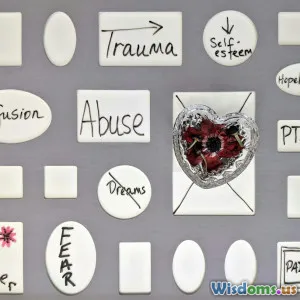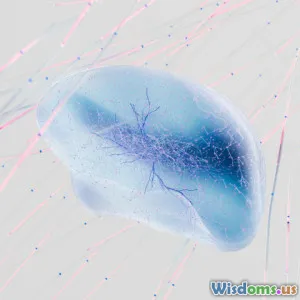
How PTSD Alters Neural Pathways in Veterans’ Minds
9 min read Exploring how PTSD reshapes veterans’ neural pathways, impacting cognition and emotional regulation with lasting effects on healing and treatment. (0 Reviews)
How PTSD Alters Neural Pathways in Veterans’ Minds
Post-Traumatic Stress Disorder (PTSD) is often painted as a mental health challenge that veterans must overcome. But what happens inside the brain itself when trauma lingers long after the battlefield has gone silent? Veterans suffering from PTSD experience not just emotional turmoil but profound, tangible changes in neural pathways that shape how memories form, how emotions are processed, and how everyday stress is handled. Understanding these neural transformations is crucial if we hope to improve treatments and bring lasting relief to those who have sacrificed so much.
The Hidden Battle Within: PTSD and the Brain
PTSD arises after exposure to traumatic events such as combat, where life-threatening situations, loss, and overwhelming stress become hardwired into the brain’s architecture. Unlike ordinary stress responses, this one becomes ‘stuck,’ leading to intrusive memories, heightened anxiety, and emotional numbness.
Veterans are disproportionately affected due to the extreme nature of their experiences. According to the U.S. Department of Veterans Affairs, approximately 11-20% of veterans who served in Operations Iraqi Freedom and Enduring Freedom suffer from PTSD. This disorder dramatically reshapes brain function and structure, fundamentally altering neural connections in key areas responsible for memory, emotion regulation, and fear responses.
Neural Pathways 101: What Gets Changed?
Our neural pathways are complex circuits of neurons transmitting signals across the brain. Think of them as highways for electrical impulses steering thoughts, memories, emotions, and behaviors. Trauma disrupts these highways through processes like neuronal loss, altered synaptic plasticity, and dysregulated neurotransmitter systems.
Hippocampus: The Memory Gatekeeper
The hippocampus plays a critical role in forming and retrieving autobiographical memories, including context and sequence of events. Research shows that PTSD induces hippocampal atrophy — a measurable loss in volume. A seminal 2006 study published in Biological Psychiatry by Woon and Hedges reviewed multiple MRI studies and confirmed that veterans with PTSD had significantly smaller hippocampi than those without.
This shrinkage corresponds with difficulties in distinguishing the past trauma from present safe environments, contributing to flashbacks and persistent distressing memories. It impairs contextual processing, trapping veterans in relentless loops of recollection.
Amygdala: The Alarm System Gone Rogue
Often described as the brain’s emotional “alarm center,” the amygdala detects threats and activates survival responses like fight, flight, or freeze. In PTSD, the amygdala becomes hyperactive, reacting to stimuli even when no danger exists.
A 2014 functional MRI study from Stanford University highlighted how veterans with PTSD exhibited increased amygdala activation in response to combat-related and neutral stimuli alike. This overactivation underpins symptoms such as hypervigilance and exaggerated startle responses.
Prefrontal Cortex: The Executive Regulator
The prefrontal cortex (PFC) manages executive functions including decision-making, impulse control, and inhibition of inappropriate emotional responses. PTSD is marked by impairments in the PFC’s ability to regulate the amygdala, leading to emotional dysregulation.
Neuroimaging evidence shows reduced activity and grey matter volume in the medial PFC of veterans with PTSD, which correlates with difficulties in extinguishing fear memories and managing distress. Without sufficient PFC oversight, the brain remains primed for survival mode.
Real-World Insights: Veterans’ Experiences Reflect Neural Changes
Speaking with veterans reveals how these neural alterations manifest in daily life. Marine Corps veteran Sarah, diagnosed with PTSD after multiple deployments, explains:
"Sometimes it feels like my brain replays the worst moments nonstop. I can’t separate what happened years ago from what’s happening now. A loud noise or sudden movement sends me back instantly."
Her experience echoes scientific findings—hippocampal impairment interferes with temporal context, making past trauma feel immediate and present.
Another veteran, John, shares how his emotions feel disconnected yet intensely overwhelming:
"I know I should calm down, but my body stays on high alert like there’s a predator around. It’s exhausting, and it’s like my brain’s alarm won’t turn off."
This is a daily struggle many veterans face, caused by the amygdala’s hyper-reactivity and PFC dysfunction.
Neuroplasticity and Hope: Brain Adaptation in PTSD
Despite neural damage, the brain retains remarkable plasticity—its ability to adapt and rewire itself. Emerging treatments leverage this plasticity to repair or compensate for PTSD-induced changes.
Cognitive Behavioral Therapy (CBT) and Exposure Therapy
These treatments aim to reframe traumatic memories and reduce fear responses by gradually confronting trauma-related stimuli. Over time, they help the PFC regain control over the amygdala, restoring emotional regulation.
Pharmacological Interventions
Medications like selective serotonin reuptake inhibitors (SSRIs) help modulate neurotransmitter imbalances seen in PTSD, particularly those affecting the hippocampus and amygdala. Newer drugs targeting neural growth factors show promise in promoting hippocampal neurogenesis.
Innovative Therapies: EMDR and Neurofeedback
Eye Movement Desensitization and Reprocessing (EMDR) stimulates bilateral brain activity, which clinical studies suggest can aid processing traumatic memories. Neurofeedback trains individuals to consciously manage brain wave patterns to reduce hyperarousal symptoms.
Additionally, cutting-edge research explores direct neuromodulation techniques such as transcranial magnetic stimulation (TMS) to enhance PFC function.
The Bigger Picture: Why Understanding Neural Changes Matters
Recognizing PTSD as a brain disorder grounded in neural pathway alterations reduces stigma, shifting public perception from a character flaw to a medical condition requiring support and treatment.
For clinicians, understanding these neural mechanisms guides precision medicine approaches, tailoring interventions to each veteran’s unique brain profile. Gary H. Wynn, a PTSD researcher, emphasizes:
"Bridging neuroscience with clinical practice is key to developing personalized treatments that go beyond symptom management to promote true recovery."
Moreover, public policy and veteran care systems can allocate resources more effectively by integrating neuroscience insights, ensuring access to therapies designed to address the profound brain changes caused by PTSD.
Conclusion
PTSD does far more than haunt veterans emotionally—it reconfigures their brain’s very wiring. Damage to the hippocampus, heightened amygdala responses, and prefrontal cortex impairments together obstruct memory processing, emotion regulation, and fear extinction. Yet within this biological upheaval lies the potential for recovery through neuroplasticity-driven therapies.
By deepening our understanding of how PTSD alters neural pathways, we unlock opportunities to develop innovative, effective treatments that honor the sacrifices of our veterans and restore hope. Education, research, and compassionate care combined hold the power to rewire not just the brain, but the future for those affected by PTSD.
References
- Woon FL, Hedges DW. Hippocampal and amygdala volumes in PTSD: a meta-analysis. Biol Psychiatry. 2006.
- Pitman RK, Rasmusson AM, et al. Biological studies of PTSD. Nat Rev Neurosci. 2012.
- Shin LM, Liberzon I. The neurocircuitry of fear, stress, and anxiety disorders. Neuropsychopharmacology. 2010.
- U.S. Department of Veterans Affairs, National Center for PTSD. Statistics on PTSD in Veterans. 2023.
Rate the Post
User Reviews
Popular Posts




















